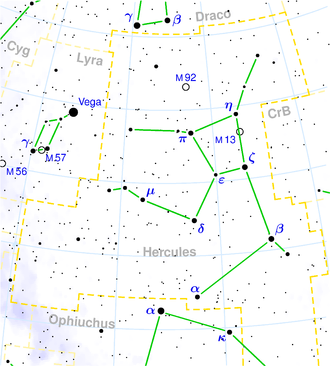NGC 6207
| Galaxy NGC 6207 |
|
|---|---|

|
|
| SDSS recording | |
| AladinLite | |
| Constellation | Hercules |
|
Position equinox : J2000.0 , epoch : J2000.0 |
|
| Right ascension | 16 h 43 m 03.7 s |
| declination | + 36 ° 49 ′ 57 ″ |
| Appearance | |
| Morphological type | SA (s) c / HII |
| Brightness (visual) | 11.4 mag |
| Brightness (B-band) | 12.1 mag |
| Angular expansion | 3 ′, 0 × 1 ′, 2 |
| Position angle | 15 ° |
| Surface brightness | 12.6 mag / arcmin² |
| Physical data | |
| Affiliation | isolated |
| Redshift | 0.002842 ± 0.000005 |
| Radial velocity | 852 ± 1 km / s |
|
Stroke distance v rad / H 0 |
(45 ± 3) x 10 6 ly (13.9 ± 1.0) Mpc |
| history | |
| discovery | Wilhelm Herschel |
| Discovery date | May 16, 1787 |
| Catalog names | |
| NGC 6207 • UGC 10521 • PGC 58827 • CGCG 197-007 • MCG + 06-37-007 • IRAS 16412 + 3655 • KUG 1641 + 369 • 2MASX J16430375 + 3649567 • GC 4231 • H II 701 • h 1969 • NSA 147222 • KIG 766 | |
NGC 6207 is a spiral galaxy with extensive star formation regions of the Hubble type Sc in the constellation Hercules in the northern sky . It is estimated to be 45 million light years from the Milky Way and about 30,000 light years across. Seen from Earth, the galaxy is tilted 68 degrees and is close to the globular cluster Messier 13 .
In the same area of the sky is u. a. the galaxy IC 4617 .
The type IIP supernova SN 2004A was observed here.
The object was discovered on May 16, 1787 by the German-British astronomer Wilhelm Herschel .
Web links
Commons : NGC 6207 - collection of images, videos, and audio files
